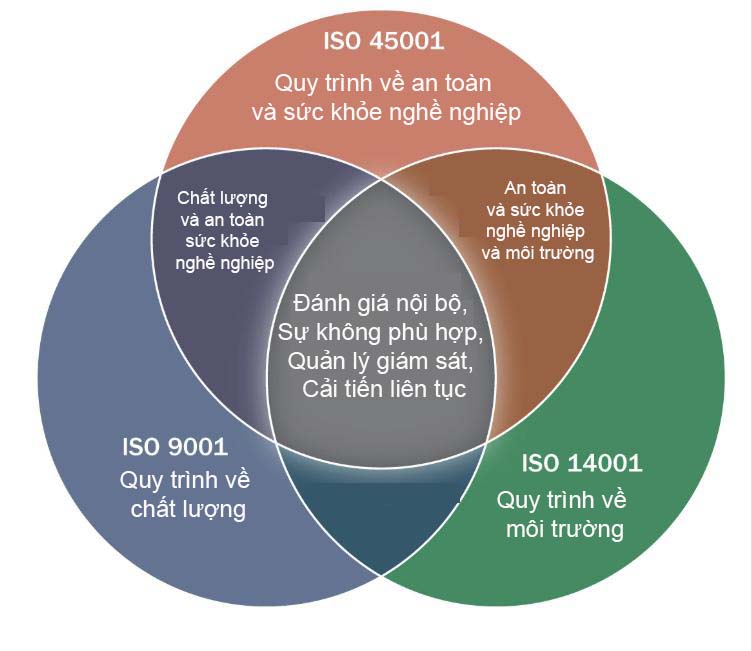Integrated Management System, also known as IMS is a term that is commonly used to integrate the followings: ISO 9001, ISO 14001, ISO 45001 standard
- Quality Management System (QMS) – ISO 9001 standard
- Environmental Management System (EMS) – ISO 14001 standard
- Occupational Health and Safety Management System (OHSMS) – ISO 45001 standard
An integrated management system is designed to streamline and simplify the management of a company’s systems, processes, and standards but it’s not the right choice for every type of organization. As a general guide, you should only consider implementing an integrated management system when you can see a clear benefit to your business. But what are the primary benefits and how can you establish whether they apply to your business or not?
I.The benefits of integrated management system implementation
There are many potential benefits that may be derived from adopting an integrated management system that covers quality, environmental and occupational health & safety processes:
- Elimination of redundancies – An integrated approach to the management of your quality, environmental and health & safety processes can eliminate redundancies through the creation of training, internal audit, and review procedures that target all three areas simultaneously.
- Improved decision-making – When you can clearly see the effects of business decisions on all areas of your company, it’s easier to choose the best course of action in any given situation. There’s no need to analyze three separate areas as all three key processes are included in an integrated system of management.
- Simplified Documentation – By implementing standard operating procedures that target quality, environmental and health & safety goals simultaneously, you can significantly reduce the amount of documentation required for internal auditing and review purposes. Simplified documentation is easier to maintain, manage and review.
- Easier to establish accountability – With an integrated management system, it’s far easier to establish exactly who in your corporate hierarchy is responsible for specific decisions and their consequences. When the three key areas – health & safety, environmental and quality processes – are divided, it can be difficult to assign responsibility for actions that affect two or more of these areas.
- Enhanced reputation – A certified integrated management system will inspire greater confidence in your company, from the perspective of prospective clients and business partners. This is an important benefit for any organization operating in a competitive commercial environment.
- Productivity improvements – An integrated management approach to quality, environmental and health & ,safety processes can lead to substantial productivity improvements. With greater accountability and streamlined decision-making procedures, your company will be able to react to changing market conditions in a more timely manner. You’ll also be able to make more effective use of internal data, to take proactive action that improves your competitive edge.
- Reduced management costs – As you can imagine, integrated management of all key areas of your business has the potential to reduce your administrative and maintenance costs considerably.
All these benefits and more have been realized by companies in diverse industries across the globe and could be realized by your business too. But is your company in a position to benefit from an integrated management system and are there any potential pitfalls of which you should be aware?
II. The importance of integrated management system preparation work
It’s important not to rush into the implementation of an integrated management system. Careful preparation and a detailed evaluation of existing processes are key to a successful implementation.
- Reconciling conflicts of interest – Environmental and health & safety goals do not always coincide with quality goals. With this in mind, it’s vital that you reconcile any potential conflicts of interest before implementing your new system. A management approach that sacrifices clarity in one or more of these areas simply to streamline business processes may not be the best choice for your organization. However, with careful preparation, major conflicts can be avoided, or accounted for, in the new management system.
- Combining the efforts of disparate departments – If your existing health & safety and quality processes are managed in entirely separate departments with little communication between the two, this will need to be addressed before introducing an integrated management system.
- Competency Issues – If by combining the management of two key processes in your business, you assign responsibility for a certain process to a manager who lacks the knowledge or expertise to deal with it effectively, problems may arise. This particular issue can either be solved through the appointment of senior personnel who possess the required experience or by encouraging existing management to work more closely together.
- Training and implementation costs – Implementing an integrated management system may bring many benefits to your organization but you need to be aware of the upfront costs. Employees at all levels will need to undergo training in the new system and senior personnel will need to document the new system in detail. These goals can be more easily achieved when working in partnership with an IMS certification specialist such as ourselves.
Evaluating your position and formulating a plan
If you would like to explore the possibility of implementing an integrated management system in your organization, an IMS-qualified consultant can help you to do so in the most effective manner possible. At DQS Center, we provide industry-leading consulting and certification services to companies in a wide range of industries across Viet Nam.

 Tiếng Việt
Tiếng Việt


